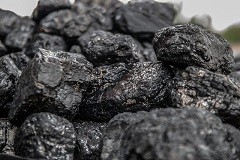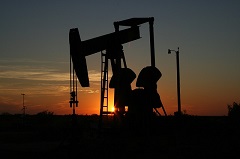Hydrocarbon resource
Hydrocarbon resources are resources that contain hydrocarbon molecules - molecules consisting of both hydrogen and carbon. Hydrocarbon resources are often known as fossil fuel resources as hydrocarbons are the primary constituent of natural gas, oil, and coal.[1] Hydrocarbon resources are the largest source of primary energy, contributing to over 85% of the world's energy.[2]
What is a Resource?
The term resource refers to the total amount of a material or primary energy available in a flow that exists. This includes fuel that is both discovered and undiscovered, economically recoverable or not economically recoverable.[3] Therefore hydrocarbon resources include the total amount of all of the hydrocarbons discovered or undiscovered on the globe.
Types of Hydrocarbon Resources
Fossil fuel resources are simply hydrocarbon resources, given a different name. Fossil fuels are a category of fuels that are made by geological processes acting on long dead organisms, often hundreds of millions of years old. Generally these resources were formed in a period of history known as the carboniferous period. Because of their age, and the time it takes to create them, fossil fuels are not considered a renewable energy source. Some of the various types of hydrocarbon resources include natural gas (shown in the first image below being flared off), coal (shown in briquette form in the center image below), and oil (with a pump jack extracting oil shown in the final image below).
- Hydrocarbon Resources
Conventional Oil
Oil is one type of hydrocarbon resource. Oil is extracted as crude oil and is distilled using fractional distillation to extract different types of fuels from the oil. Crude oil is the main liquid component of petroleum formed after kerogen is heated and compressed over large periods of time. Crude oil itself is a complex mixture of hydrocarbons, so the exact composition of petroleum is never the same. Generally crude oil is about 85% carbon by weight, and most of the rest is hydrogen. Within crude oil there are also significant quantities of sulfur, oxygen, and nitrogen.[3]
Conventional Natural Gas
Natural gas is one type of hydrocarbon resource. Natural gas is a colorless, odorless gas that burns readily and is used as a fuel fairly extensively around the world. Chemically, natural gas is mostly methane - one specific hydrocarbon molecule. Natural gas has gained popularity as a fuel over the years, especially in the US where most of the natural gas used doesn't have to be imported from other countries. Natural gas can also be used as an alternative fuel for vehicles when it is compressed in the form of compressed natural gas.
Coal
Coal is a rock formed from the decomposition of plant life. It is composed mainly of carbon, with many other trace elements. Coal's high energy density makes it useful as a fuel for electricity generation in coal-fired power plants, and in some places, heating.[7] Coal can be extracted in a number of different "grades". The lowest quality of true coal is lignite coal, then sub-bituminous, bituminous, and finally high quality anthracite coal. Peat is what coal is formed from and is technically a fossil resource, however it is not used extensively.
Unconventional Oil and Gas
Unconventional resources are resources, generally oil or natural gas resources, that do not appear in traditional formations and must use specialized extraction or production techniques to obtain fuel from the deposit. For oil and gas, conventional deposits are porous and permeable rocks below ground that contain tiny connected pore spaces that contain oil or natural gas.[8] These resources are locked in geological structures where extraction is not economically or technologically feasible, however with technological advancements these can turn into viable hydrocarbon reserves.[3] Advances in technologies including hydraulic fracturing is making the extraction of these resources more viable. Examples of unconventional deposits are shale oil, oil sands, shale gas, tight gas, and coal bed methane.
Environmental Impact
These hydrocarbon resources undergo a process known as combustion when used, and combine with oxygen in the atmosphere to form carbon dioxide and water vapour. Therefore the environmental impacts of using these resources can be drastic as the use of them releases a number of pollutants, mainly greenhouse gases into the atmosphere. In addition to these greenhouse gases, the burning of oil, coal, and natural gas contributes to pollution through the release of NOx, SOx, particulate matter, volatile organic compounds, carbon monoxide, and mercury.[3] By far the biggest concern about using fossil fuels is the impact on the climate. The large amount of carbon dioxide released by burning fossil fuels is causing changes to the Earth's climate.
Additionally, the extraction of some of these resources can result in environmental changes. Coal mining, particularly strip mining, can result in the destruction of wildlife habitats and forests to make room for mining sites. This removal of fauna can result in erosion and pollution of waterways with sediment.[9] The hydraulic fracturing necessary to obtain some unconventional natural gas is questionable because of contamination as a result of the use of fracturing fluid.[10]
The Future of Hydrocarbon Resources
Currently, there is a declining amount of hydrocarbon resources in the ground - particularly of light petroleum - but a growing demand for transportation fuels. This is confusing because hydrocarbon reserves are increasing (because technology and pricing is making more of the resource available at an economic price see Reserve vs resource). Despite the increased reserve (and decreasing resource) this increased demand and continued extraction lead a geophysicist named Hubbert to predict that the production of oil would peak in the 1970s and decline after this. This prediction regarding the decreasing production of oil is known as Hubbert's peak.[7] As consumption of resources increases alternate energy is being explored to meet emerging energy and environmental demands.[2] Some of these potential alternatives include nuclear, solar, geothermal, and wind.
References
- ↑ R.D. Botts, D.M. Carson, and D.Coglon. (June 3, 2015). "Petroleum in Our Lives" in Our Petroleum Challenge, 8th ed. Calgary: Canadian Center for Energy Development, 2013, pp. 7-15.
- ↑ 2.0 2.1 Gordon Research Conferences. (June 3, 2015). Hydrocarbon Resources [Online]. Available: https://www.grc.org/programs.aspx?id=8188
- ↑ 3.0 3.1 3.2 3.3 Richard Wolfson. (June 4, 2015). Energy, Environment, and Climate, 2nd ed. New York, NY, U.S.A: 2012.
- ↑ Tod Baker. (June 3, 2015). Natural Gas [Online]. Available: https://www.flickr.com/photos/todbaker/9148692
- ↑ Pixabay. (June 3, 2015). Coal, Briquettes [Online]. Available: http://pixabay.com/en/coal-briquette-black-471903/
- ↑ Pixabay. (June 2, 2015). Oil [Online]. Available: http://pixabay.com/en/oil-monahans-texas-sunset-106913/
- ↑ 7.0 7.1 G.Boyle, B.Everett, S.Peake, J.Ramage. (June 4, 2015). Energy Systems and Sustainability: Power for a Sustainable Future, 2nd Ed. Oxford, UK: Oxford University Press, 2012
- ↑ Alberta Energy Regulator. (June 3, 2015). What is Unconventional Oil and Gas? [Online]. Available: https://www.aer.ca/about-aer/spotlight-on/unconventional-regulatory-framework/what-is-unconventional-oil-and-gas
- ↑ US EPA. (June 4, 2015). Coal [Online]. Available: http://www.epa.gov/cleanenergy/energy-and-you/affect/coal.html
- ↑ Geology.com. (June 4, 2015). What is Shale Gas? [Online]. Available: http://geology.com/energy/shale-gas/




